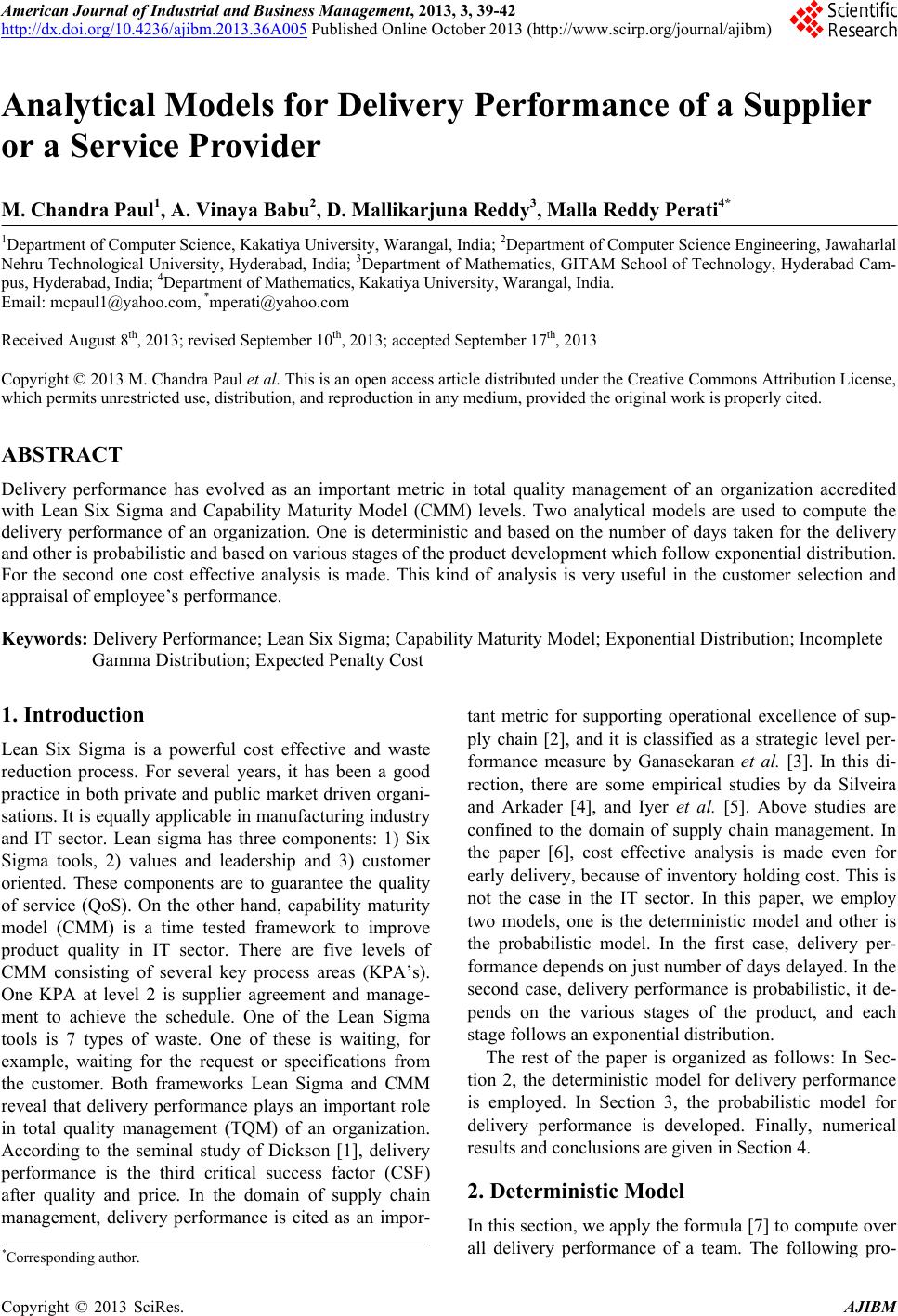
American Journal of Industrial and Business Management, 2013, 3, 39-42
http://dx.doi.org/10.4236/ajibm.2013.36A005 Published Online October 2013 (http://www.scirp.org/journal/ajibm) 39
Analytical Models for Delivery Performance of a Supplier
or a Service Provider
M. Chandra Paul1, A. Vinaya Babu2, D. Mallikarjuna Reddy3, Malla Reddy Perati4*
1Department of Computer Science, Kakatiya University, Warangal, India; 2Department of Computer Science Engineering, Jawaharlal
Nehru Technological University, Hyderabad, India; 3Department of Mathematics, GITAM School of Technology, Hyderabad Cam-
pus, Hyderabad, India; 4Department of Mathematics, Kakatiya University, Warangal, India.
Email: mcpaul1@yahoo.com, *mperati@yahoo.com
Received August 8th, 2013; revised September 10th, 2013; accepted September 17th, 2013
Copyright © 2013 M. Chandra Paul et al. This is an open access article distributed under the Creative Commons Attribution License,
which permits unrestricted use, distribution, and reproduction in any medium, provided the original work is properly cited.
ABSTRACT
Delivery performance has evolved as an important metric in total quality management of an organization accredited
with Lean Six Sigma and Capability Maturity Model (CMM) levels. Two analytical models are used to compute the
delivery performance of an organization. One is deterministic and based on the number of days taken for the delivery
and other is pro babilistic and based on various stages of the product development which follow exponential distribution.
For the second one cost effective analysis is made. This kind of analysis is very useful in the customer selection and
appraisal of employee’s performance.
Keywords: Delivery Performance; Lean Six Sigma; Capability Maturity Model; Exponential Distribution; Incomplete
Gamma Distribution; Expected Penalty Cost
1. Introduction
Lean Six Sigma is a powerful cost effective and waste
reduction process. For several years, it has been a good
practice in both private and public market driven organi-
sations. It is equally applicable in manufacturing industry
and IT sector. Lean sigma has three components: 1) Six
Sigma tools, 2) values and leadership and 3) customer
oriented. These components are to guarantee the quality
of service (QoS). On the other hand, capability maturity
model (CMM) is a time tested framework to improve
product quality in IT sector. There are five levels of
CMM consisting of several key process areas (KPA’s).
One KPA at level 2 is supplier agreement and manage-
ment to achieve the schedule. One of the Lean Sigma
tools is 7 types of waste. One of these is waiting, for
example, waiting for the request or specifications from
the customer. Both frameworks Lean Sigma and CMM
reveal that delivery performance plays an important role
in total quality management (TQM) of an organization.
According to the seminal study of Dickson [1], delivery
performance is the third critical success factor (CSF)
after quality and price. In the domain of supply chain
management, delivery performance is cited as an impor-
tant metric for supporting operational excellence of sup-
ply chain [2], and it is classified as a strategic level per-
formance measure by Ganasekaran et al. [3]. In this di-
rection, there are some empirical studies by da Silveira
and Arkader [4], and Iyer et al. [5]. Above studies are
confined to the domain of supply chain management. In
the paper [6], cost effective analysis is made even for
early delivery, because of inventory holding cost. This is
not the case in the IT sector. In this paper, we employ
two models, one is the deterministic model and other is
the probabilistic model. In the first case, delivery per-
formance depends on just number of days delayed. In the
second case, delivery performance is probabilistic, it de-
pends on the various stages of the product, and each
stage follows an expon ential distribution.
The rest of the paper is organized as follows: In Sec-
tion 2, the deterministic model for delivery performance
is employed. In Section 3, the probabilistic model for
delivery performance is developed. Finally, numerical
results and conclusion s are given in Section 4.
2. Deterministic Model
In this section, we apply the formula [7] to compute over
all delivery performance of a team. The following pro-
*Corresponding a uthor.
Copyright © 2013 SciRes. AJIBM